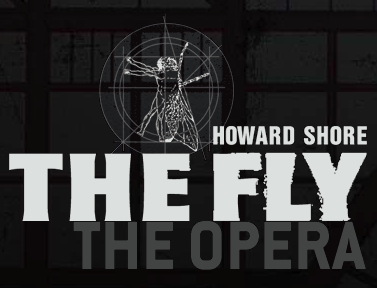
David Cronenberg's 1986 'remake' of The Fly has been among my favourite films for many years. I recall first watching it at the age of eleven and being truly repulsed and disturbed at its conclusion. The film introduced me to the decidedly warped imagination of David Cronenberg and by extension the music of Howard Shore.
The opera version of The Fly has been in development hell for what seems like an eternity. The only undeniable facts during this period were the involvement of long-time collaborators Howard Shore and David Cronenberg. It seemed slightly surreal to be taking my seat in the Theatre du Chatelet in July of this year to witness the final performance of the Paris run. At this point I wasn't sure what to expect; I had heard brief snippets of the music but not enough to form any opinion of it.
On the surface The Fly did seem well suited to becoming a stage production - both the size of the cast and the number of locations are limited - but how could the teleportation effects and Brundle's hideous physical meltdown be reproduced?
During the lengthy development of this piece, both Shore and Cronenberg have been very quick to distance it from the 1986 film; in reality it shares a number of major elements, not least of which is the plot. Aside from a shift to the 1950s and a few minor adjustments it is identical in structure and content: the inside-out baboon is there, as are the arm-wrestle and Veronica's aborted abortion. All of the film's characters survived the transition, and some of them receive more character development than they did in 1986. If those references to the film weren't enough, David Henry Hwang's eloquent (and often very funny) libretto quotes significant amounts of the film verbatim.
The shift of setting to the 1950s results in a very different look and brings increased analogue gizmo potential. The digital screens on the telepods feel a little anachronistic, but otherwise the staging is successful; the single set of Brundle's laboratory is repurposed into a hospital, a 50s dive bar and other locations with subtle assistance from the performers.
The story has been divided into two acts, the intermission occurring as Brundle teleports himself - apparently successfully - between telepods to a chorus of 'long live the new flesh' (very Videodrome). Both acts play as continuous pieces with few strictly defined scene changes. Other alterations include the telling of the story in flashback as Veronica is interviewed by police and a twist at the end, which I will not spoil here.
Fans of Howard Shore's majestic and lyrical work on The Lord of the Rings should proceed with caution - this is a very different insect. The opera opens with an excerpt from Shore's 1986 film score but this does not proceed as the listener might expect; dissonant brass takes over after a few bars to set the tone for the rest of the opera. Dissonance and atonality abound, and the music is almost universally grim throughout.
In terms of orchestration it is reminiscent of Shore's work on The Aviator (minus the castanets) - there is a similar emphasis on heavy brass and complex contrapuntal writing. There are several sequences in the opera that can only be described as montages with overlapping orchestral, choral and solo lines building to a climax - the most impressive examples of these are the teleportation sequences. In these, Brundle's computer is 'voiced' by the chorus which chants numbers and statistics in a style oddly reminiscent of Einstein on the Beach.
This was not the only element of the opera reminiscent of Philip Glass - The 'Particle Magazine Party' sequence towards the beginning of the first act is underscored with a series of whirling arpeggiations. This is one of the lighter parts of the opera and the libretto pokes fun at the supposed inadequacies of scientists.
Other stand-out sequences include Brundle's rejection of Veronica - underscored with Shore's trademark bowed cymbals and uneasy aleatoric strings - and another post-arm-wrestle 'montage' as Stathis, Veronica and a scientist discuss Brundle's mysterious insect hairs while Brundle copulates wildly with Tawny in the background.
Brundle's deterioration is perhaps the most moving sequence. The writing here is emotional but bleak, reminiscent of Shore's Looking for Richard. Brundle's physical meltdown is showcased with some appropriately gruesome latex costumes. They do not receive a huge amount of time on-stage but it must be a feat of endurance for Daniel Okulitch to wear such heavy latex and perform on a fully-lit stage.
At over two hours in length the opera is longer than the film and the pacing seems to suffer as a result. The first act leading up to Brundle's transformation feels overlong, but Brundle's final deterioration in the second act is rather rushed. This is a minor criticism; it remains a compelling piece throughout. At its conclusion the audience responded enthusiastically with none of the negativity reported at previous performances.
The Fly is recommended with reservations. It is more accessible than several of his other Cronenberg scores (Naked Lunch for example) but the unremittingly bleak tone and modernistic style may discourage some. If you can overlook that, it is a rewarding musical experience that will undoubtedly stand up to repeated viewings and listenings in the future.
-Jim Ware








